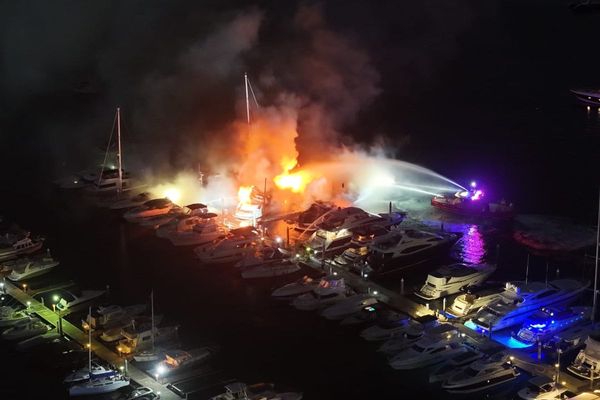Luis Melky Here-Huno — or Melky as he is known around here — is East Timor's first qualified diving instructor.
We meet in Dili, where Melky is teaching more than 40 Timorese kids how to swim and introducing them to diving theory, before taking them on their first dive.
For most of these children, Melky's lessons are their introduction to East Timor's stunning coral reefs, recognised as the most biodiverse in the world.
"I want to keep teaching Timorese people to dive and help them understand what is down in our ocean so we Timorese people can learn to take care of our coral reefs," he says.
'Everyone talks about climate change'
The Democratic Republic of Timor-Leste is one of the world's youngest nations, gaining its independence and officially changing its name in 2002, after a brutal war with Indonesia.
From its inception, the tiny nation has sought to project itself as an eco-tourism alternative to Indonesia's island of Bali, 2,000 kilometres west.
But as Timor-Leste reopens to the world post-COVID a key challenge remains: how can its pristine natural environment be maintained while building sustainable livelihoods for locals like Melky?
"Everyone is talking about climate change here — people are worried about the future of the reefs," Melky says. "I know what is inside the ocean here now — and if the coral reef is dying we won't have an industry."
From garbage collector to reef protector
Melky, 30, grew up in Dili close to the ocean, and spent much of his childhood at the beach. He never dreamed he would one day make a living as a dive teacher, but he recently won a tourism champion award for his efforts.
He was just 10 years old when the war ended and has vivid memories of huddling at the port in Dili, waiting for the United Nations peacekeepers to arrive to provide protection from occupying Indonesian forces.
"So many people had died but for young people at the time we felt very happy," he says. "Timor-Leste is very small but at least we are independent."
Melky's first job was collecting garbage in Dili. Then he worked as a security guard watching the cars of divers while they went out on diving trips.
"While I waited for them, I used to wonder what they were doing down there under water," he says.
His lucky break came when he met Kate Barker and Ivan Samra, the British and Mexican co-owners of a dive school, and began working with them in 2016 as he trained to become a dive instructor.
"I want tourism to become much bigger in Timor-Leste, but not so it becomes like the next Bali," he says. "In Bali you can see the beaches are covered in rubbish and it's just too commercial. We want more tourism, but we want it to be more natural and environmentally friendly."
The importance of the coral triangle
Melky is not the only one with a passion for preserving Timor-Leste's environment.
Catherine Kim grew up in the suburbs of Washington DC, a long way from the coral reefs of Timor-Leste.
"I first heard of the coral reefs in Timor-Leste in the first year of my PhD at the University of Queensland when the project I was working on planned a field trip there," she says.
"To be quite honest I wasn't at all familiar with Timor-Leste as a country but I was drawn to it in part because it was newly independent. In that regard I felt there was a lot to tell people about this tiny new country with amazing coral reefs."
Over four field trips between August 2014 and October 2019, Dr Kim contributed to the most comprehensive surveys of Timor-Leste's reefs ever undertaken. Together with data from XL Catlin Seaview Survey and National Oceanic and Atmospheric Administration, the research results underpinned her PhD thesis.
Part of Dr Kim's research focuses on the island of Atauro, 30 kilometres north of Dili, which boasts extraordinary coral reef habitats and associated marine biodiversity, including endangered, threatened and protected marine megafauna.
"It is part of the Coral Triangle which is the marine epicentre of biodiversity," she says. "These reefs are recognised as the most biodiverse reefs in the world. So part of my interest in studying them is a belief that this is something people really should know about."
Dr Kim's research used data from water temperature and detailed reef surveys to confirm that the tiny country's coral reefs were remarkably high in biodiversity.
She further discovered that Timor-Leste's reefs — which sit on the southern edge of the Coral Triangle, an area of ocean stretching from Papua New Guinea to the Philippines and down to Indonesia — appeared to have lower levels of bleaching compared with other reefs such as Australia's Great Barrier Reef.
"What I found from those surveys taken during the rainy season in Timor was that the temperature was a couple of degrees cooler than the satellites were picking up," says Dr Kim.
"That was interesting because those bleaching forecasts are based on satellite data of surface temperature. But [for a coral reef] a single degree of difference is quite significant. So despite the satellite predicting bleaching based on satellite data the actual temperature was below that."
Although ocean temperatures are usually warmest after summer (April in the southern hemisphere), Dr Kim's research shows that the waters in Timor-Leste were cooler than predicted when the potential for bleaching events were at their highest.
"One of my key findings was that Timor-Leste could be viewed as a climate refugium in terms of ocean warming and climate change," she says. "That cooler temperature is a significant protective factor against bleaching. So I found that while there is bleaching occurring in Timor Leste, those reefs have a bit more of a buffer in terms of ocean warming."
The world's last coral reef?
Dr Kim says if current warming trends continue, most of the coral on the Great Barrier Reef will be gone within a century but the reefs of Atauro may remain in a similar state if other threats are properly managed.
"We cannot underestimate the myriad of threats that impact coral reefs," she says. "Ocean acidification, land-based pollution, overfishing and unsustainable human activities [are some of them]. Dealing with these issues needs to coincide with managing the most significant variable threat to reef health, which is climate change."
For the nascent diving industry in Timor-Leste, there is hope that tourists and divers will be drawn to the remarkable coral wonderland in Atauro before it's too late.
"Part of the reason I have a business in Timor-Leste is to support the local people and try to do things differently," says Ivan Samra, co-owner of the Dreamers Dive Academy Timor and President of the Marine Tourism Association of Timor Leste.
"But I am not naive. Coral reefs are dying right now all over the world. Look at the Great Barrier Reef, the Cayman Islands and the Pacific Ocean.
"I am 30 years old but we speak about it every day because we are very aware that by 2040 or 2050 tropical reefs may not exist. Just by its oceanographic conditions and sheer luck, Timor Leste may be one of the last places with coral reefs left in the world within the next decades."
Today, Timor-Leste is positioning itself as an eco-tourist destination that boasts a relatively untouched natural environment compared to neighbouring Bali.
The reef is not the only thing that needs protecting
Nick Hitchins, who pilots emergency support and tourism flights between Dili and Atauro Island, says the plan – while exciting — poses significant challenges.
As well as its impressive coral reefs, Atauro Island is also home to some of the world's poorest people, Hitchins says.
"The challenge facing the Island and the rest of Timor-Leste is how to balance environmental impact with the need for survival in its rawest sense."
While flying the the 30-kilometre stretch between Dili and Atouro in a tiny Australian made Gipps Aero GA8 plane, Hitchins explains a modest $2 "reef-tax" levied on all visitors is designed to help offset the fact that locals are now not allowed to fish in protected waters.
"This goes some way to providing alternative means of livelihood," Hitchins says.
But there is a greater challenge remaining, he says.
"We must ensure that it's not just the world's wealthy who benefit from local tourism and that our Western environmental ideals don't inadvertently worsen the plight of those living in extremely isolated, impoverished societies," he says.
Traditional customs play a role
One of the ways Atauro is seeking to balance environmental and economic outcomes is through Tara Bandu, an animistic spiritual belief that uses traditional laws to manage natural resources.
"Our ancestors used Tara Bandu to protect our most sacred natural places including the fish, animals and important species," says Osaias Soares, president of the Atauro Marine Tourism Association.
"It taught people that if we go slow and tread lightly the environment will benefit us. So now we are applying Tara Bundu to our marine protected areas."
Soares says that when he was growing up on Atauro Island there were many more seabirds and animals, but their numbers have dwindled over the past two decades.
"There are only a few seabirds left now, not like when I was a little boy," he says. "Atauro used to focus more on agricultural production and livestock but because of the failure of agriculture to thrive here people switched to focusing on marine shallow water industries in the reef area."
Soares studied marine biology in New Zealand and has brought that knowledge back to Atauro to work with local tourism operators and marine conservation groups.
"We need to teach our local Timorese people about the science of the oceans and reefs here," he says. "Maybe they will tell the tourists about the life of giant clams and how they reproduce. Then they take people into the Marine Protected Area and show them the clams."
Soares knows Atauro is not immune to the threats from climate change. Coral bleaching would be a disaster for his tiny island because of its reliance on marine activities.
"We have one of the most beautiful natural resources in the world here and we are doing our best to take care of the marine area," he says as we walk along Beloi beach with the coral reefs just metres away.
"In order to keep it we ask Australia, China, America and other countries that rely on carbon production to find an alternative. Please help us in Atauro and Timor Leste because we want to protect our environment so the world can enjoy them with us."
James Norman flew to Atauro courtesy mission aviation fellowship.







